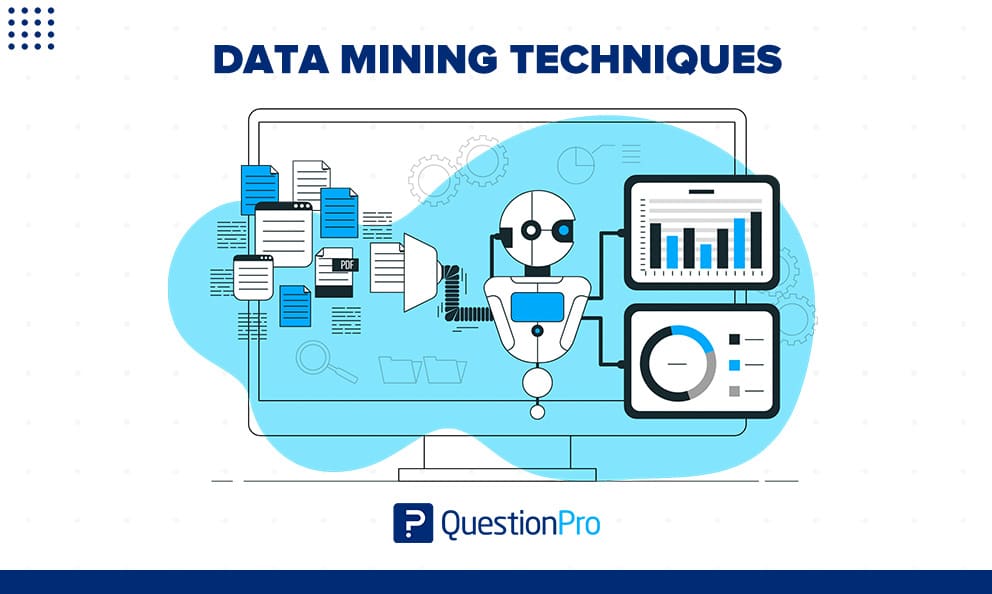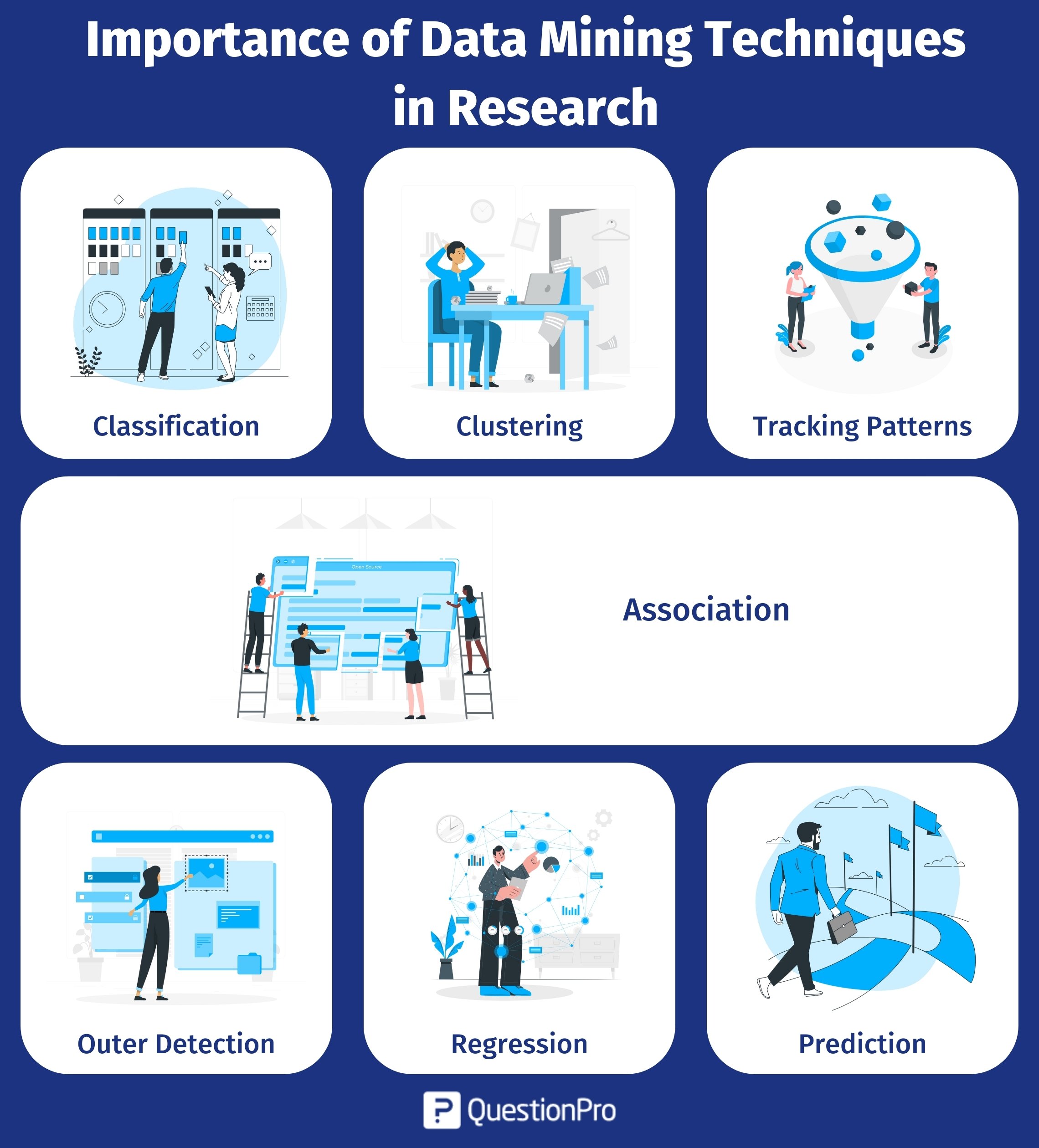
A company gathers information on sales, clients, production, personnel, marketing initiatives, and more as part of everyday operations. That’s why businesses may use data mining techniques to increase the value of this important corporate asset.
Data mining knowledge may be transformed into actionable insights information that a company can utilize to enhance marketing, forecast consumer trends, identify fraud, filter emails, manage risk, boost sales, and improve customer relations.
In this blog, we will find out what data mining techniques are and why data mining is essential in research.
Definition of data mining
Data mining is the process of systematically discovering and extracting valuable patterns, trends, correlations, or knowledge from large datasets, often using a combination of statistical and computational techniques.
The data mining process involves exploring and analyzing data to uncover hidden insights and make informed decisions, typically to solve specific problems, improve decision-making, or gain a deeper understanding of a subject.
Data mining methods can find meaningful patterns and trends in both structured and unstructured data, like sales records and customer reviews, which helps businesses make better decisions.
Defining data mining techniques
Organizations use data mining to find patterns in data that might provide insights into their operational requirements. It is necessary for both business intelligence and data science. Organizations may utilize various data mining techniques to transform unstructured data into insights that can be used.
Finding hidden, unplanned, and previously unidentified but legitimate correlations in the data is the primary goal of data mining. It is described as a method for separating valuable data from an enormous collection of raw data.
This entails utilizing one or more pieces of software to analyze data patterns in significant data sets. Research and science are only two examples of the many domains where data mining can be used.
Data may be mined using various techniques for various data science applications. Anomaly detection, which tries to find outlier values in huge data sets, and pattern recognition are common data mining use cases made possible by various techniques.
Data mining experts have devoted their efforts to improving our knowledge of how to analyze and derive conclusions from enormous amounts of information. They rely on methods and technologies from the convergence of database administration, statistics, and machine learning.
LEARN ABOUT: Data Asset Management
The importance of data mining techniques in research
Various methods are used to create models that suit the expected results depending on the company’s data mining results. The models may be used to explain present data, forecast future trends, or help identify abnormalities in the data.
Here, we’ll discuss several different data mining techniques to estimate desired results.

01. Classification
Classification is one of the most complicated data mining techniques that requires you to put different attributes into clear categories. This method is used to get information about data and metadata that is important and useful and helps set data into other groups. You can then use it to draw more conclusions or do something else.
For example, look at information about a customer’s finances and purchases. You might be able to classify data as “low,” “medium,” or “high” credit risks. You could then use these categories to learn more about these customers.
02. Clustering
Clustering is a lot like classification but involves combining chunks of data based on their similarities. It is a way to find groups of data that are similar. This process helps you see how the data is different and the same.
For example, you might divide your audience into different groups based on how much money they spend or how often they shop at your store.
03. Tracking patterns
Tracking patterns is one of the most basic ways to mine data. It means finding and keeping an eye on trends or patterns in data to draw intelligent conclusions about business outcomes. Once a company sees a trend in its sales data, it has a reason to take action to make the most of that information.
Suppose it’s found that a specific product sells better to a particular group of people than others. In that case, an organization can use this information to make similar products or services or ensure they have more of the original product for this group.
04. Association
Associating is similar to tracking patterns but more specific to variables that depend on each other. This data mining technique helps find the link between two or more things. It finds a way that was hidden in the data set.
In this case, you’ll look for events or characteristics strongly linked to another event or attribute.
For example, you could notice that when your consumers buy a particular item, they often buy a second related item. Most online stores use this to fill the “people also bought” section.
05. Outer detection
In many cases, you can’t get a clear picture of your data set just by looking at the big picture. It would help if you also spotted anomalies or outliers in your data.
For example, if almost all of your buyers are men, but there’s a big jump in the number of female buyers during a strange week in August, you’ll want to look into the jump and find out what caused it so you can either repeat it or learn more about your audience.
06. Regression
Regression analysis is used to determine the probability of a variable given the existence of other factors. This identifies and analyzes variable relationships. It determines the probability of a variable given the presence of other factors.
For example, you could use it to forecast a price depending on supply, demand, and competition. Regression helps you find the connection between two (or more) variables in a data set.
07. Prediction
Prediction is one of the strongest data mining techniques because it lets you guess what kinds of data you’ll find in the future. You often need to look at and understand historical patterns to get a pretty good idea of what will happen in the future.
For example, you could look at a person’s credit history and what they have bought to determine if they will be a credit risk in the long run.
What are data mining techniques used for?
Data mining techniques are used for various purposes in the field of data analysis and decision-making, which data analysts can benefit from. These techniques involve the process of discovering patterns, trends, associations, and valuable insights from large datasets. Here are some common uses of data mining techniques:
Predictive analysis
Data mining is often used to build predictive models that can forecast future trends or events based on historical data. For example, it can be used in financial institutions to predict credit risk or in e-commerce to forecast customer buying behavior.
Customer segmentation
Businesses use data mining to segment their customer base into different groups based on their behavior, preferences, and characteristics. This information can be used for targeted marketing and product customization.
Market basket analysis
Retailers use data mining to analyze customer purchase patterns and discover which products are frequently bought together. This information is used to optimize store layouts, cross-selling, and create product bundles.
Anomaly detection
Data mining helps identify patterns like unusual or anomalous patterns in data analytics, which can indicate errors, fraud, or security breaches. For instance, it can be used in cybersecurity to detect unusual network activities.
Recommendation systems
Online platforms like Netflix, Amazon, and Spotify use data mining techniques to provide personalized recommendations to users based on their past behavior and preferences.
Healthcare analytics
Data mining is used in healthcare to analyze patient data and identify disease patterns, treatment effectiveness, and potential outbreaks. It can also help in predicting patient outcomes.
Fraud detection
Financial institutions and credit card companies use data mining to detect fraudulent transactions by analyzing transaction history and identifying unusual spending patterns.
Text mining
Data mining techniques can be applied to text data to extract valuable information from documents, emails, social media posts, and more. This is useful for sentiment analysis, content categorization, and information retrieval.
Image and video analysis
In fields like computer vision, data mining can be used to extract features from images and videos for tasks like object recognition, facial recognition, and image classification.
Manufacturing and quality control
Data mining helps manufacturers optimize their processes by analyzing production data to identify defects, improve product quality, and reduce production costs.
Environmental analysis
Environmental scientists use data mining to analyze environmental data sets to identify trends and anomalies, monitor pollution levels, and predict natural disasters.
Education and E-learning
Educational institutions use data mining to track student performance, identify at-risk students, and personalize learning experiences.
Scientific research
Data mining is applied in various scientific fields to analyze experimental and observational data, discover patterns in genetic sequences, and assist in drug discovery.
Conclusion
These data mining techniques may all be used to research various data angles. With this knowledge, you may choose the best techniques for turning data into facts that can be utilized to deal with various company issues and boost profits, satisfy customers, or save costs.
Different data mining applications are used, depending on the research’s goals and the kind of data. You may now improve your understanding of data mining tools by using what you’ve studied about data mining’s basics and research methodology.
If you want help doing research or conducting data analysis, get in touch with QuestionPro professionals. We can guide you through the procedure and assist you in maximizing your data.







